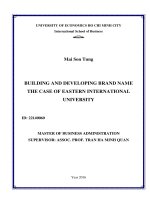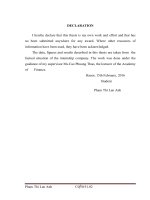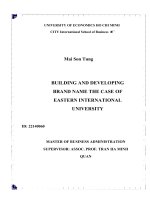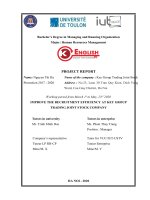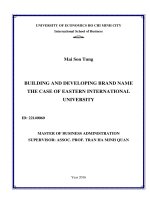Building and developing brand at phu nhuan trading joint stock company (pnco)
Bạn đang xem bản rút gọn của tài liệu. Xem và tải ngay bản đầy đủ của tài liệu tại đây (1.1 MB, 67 trang )
MEIHO UNIVERSITY
Graduate Institute of Business and Management
MASTERS THESIS
Building and Developing Brand
at Phu Nhuan Trading Joint Stock
Company (PNCo)
In partial fulfillment of the requirements for the degree of
Masters of Business Administration
Advisor: Dr. Ching-Wen Mo
Co Advisor: Dr. Pham Xuan Giang
Graduate Student: Nhu Dinh Tuyen
December, 2010
AKNOWLEDGEMENTS
First of all, allow me to thank to University Board of the Ho Chi Minh City University
of Industrial and Meiho University, Taiwan.
I would like to thank Dr. Ching - Wen Mo, professor of Meiho University, Taiwan (MU
Taiwan). Thanks to professors, teachers has participated in teaching and management, has
helped me facilitate the completion of this training program.
I would like to thank Dr Pham Xuan Giang, Assistant Professor of the Ho Chi Minh
City University of Industrial, has enthusiastically taught me the very valuable experience.
Thanks to teachers, lecturers in postgraduate training; the lecturers teachers of Faculty
of Business Administration, and the EMBA2 classmates at the Ho Chi Minh City University
of Industry.
Please also send sincere thanks to Professor, officers and administrative staff; Taiwan’s
graduate students of EMBA course at Meiho University, Taiwan.
I
Building and Developing Brand at Phu Nhuan
Trading Joint Stock Company (PNCo)
ABSTRACT
Brands play an important role for businesses, for consumers and for the economy.
Brands are intangible assets, but have great value of the business. There are many famous
companies in the world not only by the scale of investment, technological innovation, which
is due to the brand. Such as coca-cola brand value in 2010 was 70.4 billion dollars; IBM
brand is worth 64.7 billion dollars. (Interbrand 2010)
-
Brands contributed significantly increase in turnover and profit.
-
Brands to help businesses easily perform the contract, maintain traditional
customers while attracting new customers, potential customers. In fact, consumers
are often drawn, conquered by goods brands, popular and stable. For example, when
it comes to beer consumers think of Heineken beer brand, Saigon etc. These
businesses have long known brands will create and reinforce the loyalty of large
traditional customers, attracting more potential customers, even customers of rival
firms’ competition.
Strong brands, sustainable help businesses to create its image, reduce costs for trade
promotion activities, marketing activities; support businesses implement policy to penetrate
and expand markets and distribution process favorable product distribution efficiency.
Brands delivers competitive advantage for businesses, helping business has conditions
and defense against other competitors. Brands create a brand consumers trust for quality,
good prices. Consumers know the origin of products and help consumers reduce costs, time
to learn the product. Brands help protect the interests of consumers.
State trademark protection situation will prevent counterfeit, fake consumer fraud.
Famous brand encourage consumer psychology, consumers are not only willing to pay for the
product value but also pay for their satisfaction when buying products with famous brand.
In economies market, opening up and integration of the brand is a symbol of strength
and national pride. Comes to electronic goods that people are talking about Japan or wine is
said to be thinking of France. A country with many famous brands and with long tradition is a
manifestation of the survival and development. Thus, we can say that the brand is a great
valuable asset of a business, because it can affect attitudes and behavior of consumers.
II
The relationship between brands and customers can see as the conclusion. Customer
trust and loyalty in the brand and understand that the brand will benefit themselves through
the use of products and services with reasonable prices, marketing programs, promotions and
other support services. Besides, brands also assumed an important role for the enterprise,
which is to bring all staff aware and proud to work for companies with famous brands.
Keywords: Brand, Brand Consumers Trust, State Trademark Protection
III
Building and Developing Brand at Phu Nhuan
Trading Joint Stock Company (PNCo)
Contents
AKNOWLEDGEMENTS............................................................................................................ I
ABSTRACT................................................................................................................................II
Contents .................................................................................................................................... IV
Tables ....................................................................................................................................... VII
Figures.....................................................................................................................................VIII
Chapter1 Introduction ..................................................................................................................1
1.1 Background and Motivation ..............................................................................................1
1.1.1 Company profile PNCo.............................................................................................1
1.1.2 Status and development prospect of the Company compared to other enterprises
in the same industry. ................................................................................................2
1.1.3 Assessing the suitability of the Company’s development orientation toward the
industry orientation, the State policies and general trends in the world. .................3
1.1.4 Technological level. ..................................................................................................3
1.1.5 The situation of research and development of new products....................................4
1.1.6 The situation of product quality inspection. .............................................................4
1.1.7 Marketing activities. .................................................................................................4
1.1.8 Company name, logo, trademark. .............................................................................5
1.1.9 Labor structure, regulations and policies related to employees................................5
1.2 Research Objectives and Research Questions ...................................................................6
1.2.1 Research objectives...................................................................................................6
1.2.2 Research questions....................................................................................................7
1.3 Research Scope and Limitations........................................................................................7
1.3.1 Research scope..........................................................................................................7
1.3.2 Limitations. ...............................................................................................................7
Chapter 2 Theoretical Basis of Brand Building...........................................................................1
2.1 The Concept of Branding...................................................................................................1
2.1.1 The definitions of branding.......................................................................................1
2.1.2 Distinguishing the brand and trademark. ..................................................................1
2.2 Process of Building and Developing Brand.......................................................................2
IV
2.2.1 Develop overall strategy. ..........................................................................................3
2.2.2 Identify the brand elements.......................................................................................7
2.2.3 Brand protection......................................................................................................11
2.2.4 Building media strategy. .........................................................................................11
2.2.5 Measurement and correction branding....................................................................13
2.3 Strategic Branding ...........................................................................................................14
2.3.1 Competitive strategy. ..............................................................................................14
2.3.2 Quality in competitive trends and brand building...................................................16
Chapter 3 Research Methods .....................................................................................................20
3.1 Research Process..............................................................................................................20
3.2 Research Methods............................................................................................................22
3.2.1 Research on qualitative. ..........................................................................................22
3.2.2 Research on quantitative. ........................................................................................23
3.3 Questionnaire Design.......................................................................................................23
3.4 The Accuracy of Data ......................................................................................................24
3.5 The Reliability of Data.....................................................................................................24
Chapter 4 Analysis and the Results............................................................................................26
4.1 General Information Objects Through a Questionnaire Survey ......................................26
4.1.1 Results of the gender...............................................................................................26
4.1.2 Results of the age. ...................................................................................................26
4.1.3 Results of the education level. ................................................................................27
4.1.4 Results of the career. ...............................................................................................28
4.1.5 Results of the working time. ...................................................................................28
4.2 Opinion Results about the Determinant Groups of Building and Developing Brand
Strategy of PNCo Company ..............................................................................................29
4.2.1 Results of evaluation of vision and mission. ..........................................................29
4.2.2 Results of Assessment of Brand Positioning ..........................................................30
4.2.3 Results of the assessment of elements of brand......................................................31
4.2.4 Results of assessment of character and essence of the brand. ................................32
4.2.5 Results of the assessment of communication strategy. ...........................................33
4.2.6 Results of the assessment of synchronization strategy building and developing
brand of PNCo. ......................................................................................................34
Chapter 5 Conclusions and solutions.........................................................................................35
5.1 Conclusions......................................................................................................................35
V
5.1.1 The advantages........................................................................................................35
5.1.2 The limitations need to change. ..............................................................................36
5.2 Solutions ..........................................................................................................................37
Reference ...................................................................................................................................39
APPENDIX A - English Questionnaire .....................................................................................42
APPENDIX B – Vietnamese Questionnaire ..............................................................................46
VI
Tables
Table 1-1 Labor Classifications ..................................................................................................5
Table 2-1 Can See the Difference between the Two Terms Through the Following Chart ........2
Table 2-2 Comparison of Brand Model ......................................................................................6
Table 2-3 Criteria for Measuring Brand Strength by Interbrand ..............................................14
Table 3-1 Reliability of Survey Data ........................................................................................24
Table 4-1 Results of the Gender................................................................................................26
Table 4-2 Results of the Age .....................................................................................................26
Table 4-3 Results of the Education Level .................................................................................27
Table 4-4 Results of the Career.................................................................................................28
Table 4-5 Results of the Working Time ....................................................................................28
Table 4-6 Results of Vision and Mission ..................................................................................29
Table 4-7 Results of Assessment of Brand Positioning ............................................................30
Table 4-8 Results of the Assessment of Elements of Brand .....................................................31
Table 4-9 Results of the Evaluation of Character and Essence of Brand .................................32
Table 4-10 Results of the Assessment on Communication Strategy.........................................33
Table 4-11 Results of the Assessment of Synchronization Strategy Building and Developing
Brand of PNCo........................................................................................................34
VII
Figures
Figure 1-1 Logo PNCo................................................................................................................5
Figure 2-1 Process of Building and Developing Brand ..............................................................2
Figure 2-2 The Process of Establishment of the Mission Statement ..........................................4
Figure 3-1 Research progress is made follow the steps shown specifically by the
following diagram...................................................................................................22
VIII
Building and Developing Brand at Phu
Nhuan Trading Joint Stock Company
(PNCo)
Chapter1 Introduction
1.1 Background and Motivation
Integrate into the deeper world economy, Vietnam enterprises must understand
many areas such as economic, scientific, technical, market etc., be aware of the fierce
competition of the market. To survive and develop, the enterprise have no other way
except to build yourself a strong brand, firm to compete with other products, other brands
of domestic and foreign enterprises.
In a small book of Johnson and Johnson company reaffirmed that “The company
name and brand is the most valuable assets of the enterprise.” According to James R.
Gergory and Duong Huu Hanh, a strong brand name can bring the benefits as follows:
-
Will bring better business results: revenue and higher profits.
-
The financial situation better
-
A strong and well know brand make customers trust, secure and proud to use
the services and products.
-
Maintaining of loyal customers and attract new clients.
-
Reduced marketing costs, facilitate the conduct of marketing activities such as
launching new products, new services, expand the brand, expanding distribution
channels.
-
Strong brand is easy attracting investors and talent.
-
Strong brand will create barriers for competitors. (Duong Huu Hanh, 2005,
Administrative Brand Equity.)
1.1.1 Company profile PNCo.
Phu Nhuan Trading Joint Stock Company is formerly Phu Nhuan Trading
Company was established in 1992, with the ownership is a State enterprise.
1
On 03/11/2003, implementing policies equalization of State, People's Committee of
Ho Chi Minh City issued a decision 4735/QD-UB about transfer Phu Nhuan Trading
Company to Phu Nhuan Trading Joint Stock Company.
On 11/06/2004, the company officially went into operation with the certificate of
business registration No. 4103002394 by the Department of Planning and Investment of
Ho Chi Minh City issued.
Company’s capital is 36 billion.
Some branches of the company:
-
Trading: Import - Export (domestic and foreign markets).
-
Producing and processing agricultural products
-
Services: Hotels, restaurants, leasing warehouses, offices, shops etc.
-
Investment: finance, construction etc. (Phu Nhuan Trading Joint Stock Company,
2010, statement).
1.1.2 Status and development prospect of the Company compared to other
enterprises in the same industry.
The company's position in the industry: Company have been established long ago
with business functions Commerce - Services - Export, PNCo brand name is increasingly
more customers in and outside the country known. Also, with a long history in business
process product consumption market familiar and loyal customers, the company has
made a lasting reputation and gained the trust of customers, so the position of the
company on the market is firm, stable consumption market share and revenue growth,
profit of the company through the years is quite high.
Items of business of the company’s main export are coffee Robusta and cashew
kernels; it occupies a large proportion of the total export turnover of the company. In
addition, the company also exports other agricultural products such as straw mushrooms,
canned fruit etc.
The company is also managing, using and exploiting some building in the center
city; this is one of advantage of company that can develop business services restaurants
and other investment projects on leased office buildings and hotels.
2
Development prospects of the company: After three years of joining WTO, the
main agricultural products of Vietnam like rice, coffee, rubber, pepper, tea etc. have been
confirmed in the position where most of the continent with export volumes of “top”
leading of the world. According to the general development trend of the economy, the
demand for office buildings and apartments for rent is increasing while company has
advantages in this product line. (Phu Nhuan Trading Joint Stock Company, 2010,
statement)
1.1.3 Assessing the suitability of the Company’s development orientation
toward the industry orientation, the State policies and general trends in
the world.
Orientation of the company is continuing to maintain and focus on developing
import and export trade with the main products are coffee, cashew kernels, straw
mushroom. At the same time, diversify the business services that contribute increasing
value and service quality and also have contributed to spread the risk in business
activities of the Company. This is entirely consistent with the development of the sector,
the State's policies and general trends in the world. In addition, the investment and
development business shopping center, office buildings, apartments for rent is to
contribute to the branding and developing company. (Phu Nhuan Trading Joint Stock
Company, 2010, statement)
1.1.4 Technological level.
The Company focuses on developing technology level information relating to
internal management systems, aimed at professionals, enhance the business performance
of the Company. In order to promote widely to partners, customers and shareholders
about the information and images of PNCo, the system of the company website was born,
complete and always updated regularly, it contribute to creating an intimate relationship
and friendly image of PNCo with partners, existing and potential customers of the
Company. (Phu Nhuan Trading Joint Stock Company, 2010, statement)
3
1.1.5 The situation of research and development of new products.
With many years of working in the field of commercial services, management team
and staff of PNCo has accumulated many experience. Utilize and promote this
advantages, the company will continue to invest and develop the traditional item is export
of agricultural products, and gradually balance between export and food services
including constantly increasing proportion of food especially in the field of conferences weddings, birthdays etc. and service offices, apartments and rental housing to meet
growing needs in society. Currently, the company is expanding its business activities in
some localities in which the canned straw mushrooms enterprise in Dong Thap Province
is also in the development strategy of the company's new products. (Phu Nhuan Trading
Joint Stock Company, 2010, statement)
1.1.6 The situation of product quality inspection.
In addition to coordinating with the quality management agencies check quality of
products and services of the Company, the company also built a system of quality control
standards appropriate to each particular field of activity, for the purpose of inspection and
supervision to provide customers with products and services with best quality. (Phu
Nhuan Trading Joint Stock Company, 2010, statement)
1.1.7 Marketing activities.
To enhance the promotion and raise brand image PNCo through advertising on
mass media and electronic information website of the Company.
Clearly defined groups of target customers, thereby, offering promotions program
to suit each customer and the purpose of long-term sustainable development as well as
immediate objectives of the Company.
In parallel, PNCo brand known through support programs such as gifts, funding for
humanitarian programs, hand love and gratitude homes etc. (Phu Nhuan Trading Joint
Stock Company, 2010, statement)
4
1.1.8 Company name, logo, trademark.
Company Name
: CÔNG TY CỔ PHẦN THƯƠNG MẠI PHÚ NHUẬN
English Name
: PHU NHUAN TRADING JOINT STOCK COMPANY
Abbreviation
: PNCo
Logo – Trademark
:
Figure 1-1 Logo PNCo
Source: Phu Nhuan Trading Joint Stock Company, 2010, statement
1.1.9 Labor structure, regulations and policies related to employees.
Employees of the company at 30/05/2010 are 177 people, with the structure of
labor as follows:
Table 1-1 Labor Classifications
Number
I.
1.
2.
3.
4.
5.
II.
1.
2.
Labor
classification
Education level
Upper university
University
Colleges
Intermediate
Other
Labor level
Official
Temporary
People
1
16
20
30
110
Rate
0,56%
9,03%
11,29%
16,91%
62,21%
177
100,00%
177
100,00%
Source: adjusted, Phu Nhuan Trading Joint Stock Company, 2010, statement
Recruitment Policy: To enhance human resource management in a professional
manner and contributing to increased efficiency of production and business of the
5
Company, PNCo has built regulations on recruitment on the basis of State laws, rule and
regulations of the Company. Recruitment is the process of finding, selecting the right
people in the right place and right time to meet labor needs in the company.
Training Policy: Training and developing human resource is a strategic solutions to
create competitive advantage of companies, has effect to maintain and improve the
quality of human resources, to meet the needs and aspirations of development of
employees, helps the laborers regularly updated knowledge to perform their functions and
duties of themselves with voluntarily work and better attitudes, created for employees a
new ways of thinking and work as a basis for promoting creativity, professionalism, and
improve adaptability to work in future-oriented development of the Company, in time
meet the performance business strategy of the company. Therefore, training and
developing human resource is a top priority of the company.
Through the issues mention above, the purpose of research and development
building brands will help the company position, improve its competitiveness to survive
and grow. (Phu Nhuan Trading Joint Stock Company, 2010, statement)
1.2 Research Objectives and Research Questions
1.2.1 Research objectives.
With the problems described above, to implement the building and developing the
company's brand into a strong brand and have reputation in the competitive situation then
the company must perform 6 objectives following:
(1) Identify the vision, mission of PNCo;
(2) PNCo brand positioning;
(3) Building brand element of PNCo;
(4) Building character and essence of the brand of PNCo;
(5) Building and developing communication strategy of PNCo;
(6) Strategic brand development PNCo to become strong brands, has branches in
different products, with highly competitive in Vietnam.
6
1.2.2 Research questions.
To implement these goals we need to answer the questions:
(1) PNCo is necessary to determine the vision, mission yet?
(2) PNCo brand positioning is needed yet?
(3) PNCo is necessary to build the elements of the brand yet?
(4) PNCo is necessary to build the character and the essence of the brand yet?
(5) PNCo is necessary to build and develop media strategies yet?
(6) PNCo is necessary to build brand development strategy to become a strong brand,
has branches in different products, with highly competitive in Vietnam yet?
1.3 Research Scope and Limitations
1.3.1 Research scope.
The scope of implementation is the company's customers, staff and employees in
all departments, branches of the company's business and leaderships of company in Ho
Chi Minh City, Dong Nai Province, Gia Lai Province, Vinh Long Province, and Dong
Thap Province.
1.3.2 Limitations.
Limitations of the project are only research the building and developing brands in
markets where companies have business facilities such as Ho Chi Minh City, Vinh Long
Province, and Dong Thap Province.
7
Chapter 2 Theoretical Basis of Brand
Building
2.1 The Concept of Branding
2.1.1 The definitions of branding.
David A. Aaker (1991) proposed that brand determine the origin of the product and
a sign make company easy distinctive. He said a brand is a distinguishing name and / or
symbols (such as logos, trademarks evidence, or design packaging) knowingly identify
goods and services or a seller or a group of seller and to distinguish goods and services
with the goods and services of competitors.
According to Philip Kotler (1995): “Branding can be interpreted as names, terms,
symbols, graphics or the combination of them to confirm the seller of products and to
distinguish them from rival products.”
Besides, Ambler & Styles (1996) explain that branding is a collection of attributes
which provide benefits and value to targeted customer they find.
2.1.2 Distinguishing the brand and trademark.
The term of trademarks and brand name are used to distinguish the products,
services or difference organization. However, the trademark is often used in legal
documents. For example, under Article 72, Intellectual Property Law on 2005, trademark
is defined as follows: “Trademark is the visible sign under the form of letters, words,
pictures, images including images of three-dimensional image or combination of that
factors, is represented by one or more colors are capable of distinguishing goods or
service of trademark owner's with other goods and services owner’s.”
1
Table 2-1 Can See the Difference between the Two Terms Through the Following Chart
Trademark
Brand name
Enterprises registered with the State Enterprises building and customers rated
agencies as prescribed by law.
with their experience.
Express certification of State agencies.
Demonstrating confidence and loyalty of
customers.
Building base on the legal system and Building base on the system of enterprises
appear on legal documents.
organizations and present in the minds of
customers.
Be protected by law, a sole proprietorship Customers love and acceptance is the
enterprises and others to use prohibited.
differentiation of customers when they
heard the name of the business.
There are specific values, obviously.
Abstract value, difficult to evaluate.
Tangible: registration, certification.
Intangible: love, loyalty.
Used in legal provisions.
Used in the economic field.
Source: Luat gia pham, 2010
2.2 Process of Building and Developing Brand
The process of building and developing brand is made of five steps:
-
Step 1: Develop the overall strategy
-
Step 2: Identify the brand elements
-
Step 3: Protect the brand
-
Step 4: Develop communication strategy
-
Step 5: Measurement and correction
Develop
the overall
strategy
Identify the
brand
elements
Protect the
brand
Develop
communica
tion
strategy
Figure 2-1 Process of Building and Developing Brand
Source: Lantabrand, 2010
2
Measureme
nt and
correction
2.2.1 Develop overall strategy.
Develop overall strategy is to identify long-term goals, outlined guidelines,
directions and how to achieve that goal. With an overall strategy clearly planned from the
start, businesses will know where and how to get to the destination. Create a solid
foundation and an important basis for the selection of strategic and objectives in the
future. All activities related to brands must compliance and close to the overall strategy to
ensure perform synchronization, right direction, efficient use of resources, saving time
and cost.
2.2.1.1 Identify the brand vision.
Chernatony (2001) believes that a powerful brand vision indicates the long-term,
stretching intent for the brand which must excite staff, en-courage their commitment and
enable them to interpret how they can con- tribute to success. Besides, Ngoc Quang
(2005) considers that vision is a picture, a vivid picture of what can happen in a brand's
future. It suggests a long-term orientation, which shows the desire, and the determination
of the brand name of what desire would reach. Vision brand was created on the basis
question: In the long term future, what is the brand wants to achieve? Common vision
towards this ideal and perfect in a distant future. A vision leads to success is to bring
long-term vision and determination; have pioneering character, leading and creative in
find ideas; agreed on the objectives, orientation and use resources efficiently, encourage
and motivate employee's work.
2.2.1.2 Identify the brand mission.
“The mission of the brand is a concept refers to the brand's purpose, rationale,
significance of the birth and existence of it”
Mission brand is often built on the basis of customer orientation. It represents a
long term goal that brand commitment to customers, customers that the brand will focus
on service, things that make a difference which brand trying to build, and financial targets
which brand will contribute.
To form a mission statement, business usually answers the following issues:
-
Customers: Which customers is brand meeting the needs of?
-
What are products or services of the enterprise?
3
-
Where is the main enterprise market?
-
Technology is the leading concern of business or not?
-
Concern for the survival, development and profitability: the enterprise is
constrained by economic goals or not?
-
Philosophy: what are values, aspirations and philosophy of business activities?
-
Culture: What are the standard rules and basic beliefs of business?
-
What are competitive advantage and special power of business?
-
Community image have a concern primarily of business?
-
The care staff: How is the attitude of business to employees? Do the employee
is a valuable asset of the business or not?
However, not all mission statement which also includes all the above problems.
Depending on the objectives and business strategies those enterprises give reasonable
choice.
Formed
initial ideas
about the
brand
mission
statement
Surveying
the external
environme
nt and
conditions
identified
Redefine
idea about
the brand
mission
statement
Build
brand
mission
statement
Implement
ation brand
mission
statement
Review
and modify
the mission
Figure 2-2 The Process of Establishment of the Mission Statement
Source: Ngoc Quang, 2005, Brand Vision
2.2.1.3 Brand positioning.
“Positioning” has become a very popular term in business and marketing.
According to Jack Trout, who have the greatest impact on brand positioning theory:
“Positioning is what business commitment and it exist the minds of consumers when
heard of such enterprises?”
So the positioning includes two parts:
1. Determine what business want customers see, evaluate and feel about their brand.
2. Coordinate activities for customers to remember the brand in a certain position in
their mind.
4
Businesses always want to create and occupy a place memorable in the minds of
potential customers. However, not only businesses want to locate in any position but also
must consider factors such as capacity, customers and competitors to determine the
position where we can achieve and efforts to implement activities how to achieve the
target position.
There are many ways to create a competitive advantage. Positioning follows the
attribute, the benefits, the use, the users, the competitors, product categories, the quality
or the price etc. Next is to analyze competitors both directly and indirectly to find out
their strengths and their weaknesses. Then, analysis of the business and brand in all
aspects: finance, marketing, human resources, technology, market, brand awareness.
Enterprises can use SWOT model or combination with PEST model to analyze and find
out the value, benefits, and the different features which products and services of the brand
or even different in thought, in the minds of customers to position the success.
Over time, even a better position but at some time in future, businesses will also
need repositioning. Because the needs of customers’ tastes can change, new competitors
appear, or position of enterprise is no longer fit reality. When you change the position of a
brand to make sure the new location is appropriate to retain old customers while
attracting new clients. (Tran Nha, 2004, Brand Positioning)
2.2.1.4 Select brand model.
In the overall strategy, a very important content should be clearly defined from the
start is choosing the model and brand structure.
There are three major brand models:
-
General brand: Enterprise is only building a single brand, all products and
services of enterprises have brought a brand.
-
Individual brand: Enterprise is building individual brand for each products and
services, each product has a separate brand.
-
Multi Brand: Enterprise is build general brand and also build individual for each
products and services.
Table comparing the advantages and disadvantages of the brand model
5
Table 2-2 Comparison of Brand Model
Model
General brand:
Just build a single
brand. All
products and
services of
enterprises have
brought a brand.
Advantages
- The consistency of the brand helps
customers easily understand and
catch the value and vision of the
brand.
- Get the visibility of the brand
orientation, simple management
capabilities.
- All activities are contributing to
increasing brand value.
- Advantages when launching new
products.
-Building costs and developing brand is
low.
Individual brand: - Allows control of the product
Enterprise is
lifecycle.
building
- Highlighting the characteristics of
individual brand
products and services.
for each products - Brand of business is not affected when
and services, each
a product or service failure.
product has a
- Can be launching new products to
separate brand.
compete in the same market.
- Easy to purchase brand, other
products.
Multi Brand:
Enterprise is
build general
brand and also
build individual
for each products
and services.
- Exploiting the maximum advantage
and the support between the brands,
creating opportunities for product
penetrate and developing market.
- Customer is oriented.
- Take advantage of the prestige of the
brand as the enterprise platform to
support and create confidence for the
brand of products and services.
- Can do business products in many
areas.
Source: Nguyen Q. Thịnh, N. T. Trung, 2009
6
Disadvantages
- Capability expands items
and activities fields
were limited.
- Failure of any products
or services also has
disadvantage effects for
the brand.
- Costs of launching new
products, building and
maintaining brand is
high.
- Requires high capacity
management.
- Less contribute to the
enterprise brand value.
- Customers do not know
who they buy product.
- Duplication of resources.
- The support between the
brand's business almost
no.
- Brands need more time
to build.
- Building costs and
developing brand are
high.
2.2.1.5 Identify objectives and plans.
A building and developing complete brand strategy must reflect the goals and plans
in each period. All must be set in a concrete and detailed, must be measured through
quantifiable by numbers, feasible and have set specific timelines. To achieve the
objective of the brand, companies need a plan of financial and personnel. The budget for
the brand and people to make and implement control strategies to ensure the right track
and effectively.
2.2.2 Identify the brand elements.
The business needs to determine factors, including:
-
The elements of brand awareness
-
Benefits and trusted of brand
-
Character of brand
-
Essence brand
2.2.2.1 The elements of brand awareness.
As these signs can be expressed in words, read or sound effects on hearing such as
name, slogan, or music signs are identified through visual as drawings, logos, packaging
and color. For a brand easy to memorable, easily recognizable, accepted, preferred and
loyal customers, these factors need to be built in a harmonious and consistent,
demonstrating the brand's meaning, comply with core values based on the vision, mission
and positioning of the brand. If the vision and the mission are viewed as the foundation of
the brand of these factors are the basic materials to create the brand. (Trong Tan, 2004)
2.2.2.2 Benefits and brand trust.
Branding contribute to create value to consumers, a feeling of luxury and honor. A
famous brand will give customers a certain value. Brand to create a psychological assured
of quality when consumers choose a brand that is, it was putting their faith in the brand.
They are completely assured of quality goods and services supplied. (Nguyen Q. Thịnh,
N. T. Trung, 2009)
2.2.2.3 Brand personality.
As a special factor, expressing human characteristics associated with the brand. It
is expressed through the characters, real people, real objects or images to describe the
7


